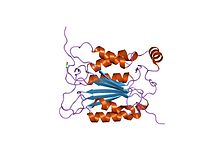Caspases
| Caspase domain | |||||||||
|---|---|---|---|---|---|---|---|---|---|

Structure of interleukin-1 beta-converting enzyme.
|
|||||||||
| Identifiers | |||||||||
| Symbol | Peptidase_C14 | ||||||||
| Pfam | PF00656 | ||||||||
| Pfam clan | CL0093 | ||||||||
| InterPro | IPR002398 | ||||||||
| PROSITE | PS50208 | ||||||||
| MEROPS | C14 | ||||||||
| SCOP | 1ice | ||||||||
| SUPERFAMILY | 1ice | ||||||||
|
|||||||||
| Available protein structures: | |
|---|---|
| Pfam | structures |
| PDB | RCSB PDB; PDBe; PDBj |
| PDBsum | structure summary |
Caspases (cysteine-aspartic proteases, cysteine aspartases or cysteine-dependent aspartate-directed proteases) are a family of protease enzymes playing essential roles in programmed cell death (including apoptosis, pyroptosis and necroptosis) and inflammation. They are named caspases due to their specific cysteine protease activity – a cysteine in its active site nucleophilically attacks and cleaves a target protein only after an aspartic acid residue. As of 2009, there are 11 or 12 confirmed caspases in humans and 10 in mice, carrying out a variety of cellular functions.
The role of these enzymes in programmed cell death was first identified in 1993, with their functions in apoptosis well characterised. This is a form of programmed cell death, occurring widely during development, and throughout life to maintain cell homeostasis. Activation of Caspases ensures that the cellular components are degraded in a controlled manner, carrying out cell death with minimal effect on surrounding tissues.
Caspases have other identified roles in programmed cell death such as pyroptosis and necroptosis. These forms of cell death are important for protecting an organism from stress signals and pathogenic attack. Caspases also have a role in inflammation, whereby it directly processes pro-inflammatory cytokines such as pro-IL1β. These are signalling molecules that allow recruitment of immune cells to an infected cell or tissue. There are other identified roles of caspases such as cell proliferation, tumour suppression, cell differentiation, neural development and axon guidance and ageing
Caspase deficiency has been identified as a cause of tumour development. Tumour growth can occur by a combination of factors, including a mutation in a cell cycle gene which removes the restrains on cell growth, combined with mutations in apoptopic proteins such as Caspases that would respond by inducing cell death in abnormally growing cells. Conversely, over-activation of some caspases such as caspase-3 can lead to excessive programmed cell death. This is seen in several neurodegenerative diseases where neural cells are lost, such as Alzheimers disease. Caspases involved with processing inflammatory signals are also implicated in disease. Insufficient activation of these caspases can increase an organism's susceptibility to infection, as an appropriate immune response may not be activated. The integral role caspases play in cell death and disease has led to research on using caspases as a drug target. For example, inflammatory caspase-1 has been implicated in causing autoimmune diseases; drugs blocking the activation of Caspase-1 have been used to improve the health of patients. Additionally, scientists have used caspases as cancer therapy to kill unwanted cells in tumours.
...
Wikipedia
